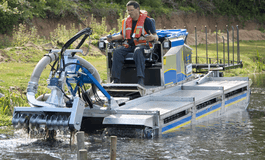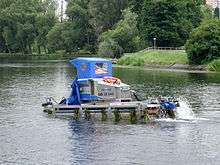Aquatic weed harvester
An aquatic weed harvester, also known as a water mower,[1][2] mowing boat and weed cutting boat,[3] is an aquatic machine specifically designed for inland watercourse management to cut and harvest underwater weeds, reeds and other aquatic plant life.[4] The action of removing aquatic plant life in such a manner has been referred to as "aquatic harvesting".[5]


Overview
Water is an important resource and in many countries, waterways are increasingly clogged by aquatic plant growth. This is particularly so in tropical countries where warmer water means the plants grow more quickly, and increasing run-off of fertilisers and effluent has exacerbated the problem. Irrigation ditches and pumps can become overgrown with vegetation, power station and factory water intakes can get blocked, boats can get hindered, fish stocks can be disrupted, and water moves more slowly, resulting in greater evapotranspiration and a greater risk of flooding. In some large irrigation projects in India, canals have become so overgrown with vegetation that water flow has been reduced to a fifth of its previous amount. In Bangladesh, floodwater has washed mats of water hyacinth onto paddy fields, overwhelming the emerging rice crops.[6] Small fish can become entangled in excessive algal growth.[5]
Rice is the main aquatic plant grown for human food, but smaller areas of watercress and water chestnut are also cultivated. In their native environments, aquatic weeds are part of a balanced ecosystem, and it is mainly introduced species of water plant that become invasive and cause problems by congesting water bodies. The worst culprits, found in both temperate and tropical waterways, are floating plants such as water hyacinth, water lettuce and Salvinia, fully submerged rooting plants such as Hydrilla and water milfoil and rooting plants that reach the surface such as cattail, papyrus, bulrush and reed.[6]
Weed harvesting equipment
Weed cutting boats are developed to enable the maintenance of canals, lakes and rivers[4] and to remove excessive aquatic life such as algae and other plants that may negatively affect a waterway's ecology. Mechanical harvesters are large floating machines that have underwater cutting blades that sever the stems of underwater plants, gather the weeds and raise them on conveyor belts, storing the vegetation on board in a hold. Periodically this is discharged to a barge or an onshore facility. The harvested product can be composted, sent to a landfill site or used in land reclamation.[7] In developing countries aquatic vegetation may be harvested by hand or by net from the shore, cut and harvested by boat and lifted ashore by hand, crane, pump or conveyor system. The harvested vegetation may be used for the feeding of livestock. To reduce the high moisture content and to make it easier to transport, the weed can be chopped and pressed.[8] Other uses to which the harvested vegetation can be put include ensiling the material for livestock fodder, adding it to the soil as a bulky organic fertilizer, manufacturing the raw material into pulp, paper or fibre, and fermenting it to produce methane for energy production.[6]
Advantages and disadvantages
Mechanical harvesters can be effective at clearing aquatic weeds but the machines are expensive and the process may need to be repeated several times in a growing season. Small fragments of weed remain in the water and may spread to other locations thereby aiding in the dispersal of invasive species. Some areas may be too shallow for the mechanical harvester and it may be unable to access restricted locations.[7] Submerged tree stumps can damage the machine.[5] Aquatic weeds can also be utilized as a source of biofuel.[9] An alternative to mechanical harvesting is the use of herbicides, which are easy to apply and less expensive, but may have unwanted adverse impacts on the environment.[10]
By region
Africa

In June 2015 in Uganda, use of the aquatic weed harvester was recommended by the country's Ministry of Agriculture to reduce water hyacinth growth in Lake Victoria, which has caused a scarcity of fish in the lake.[11] The scarcity of fish has negatively-affected the livelihood of locals who live in the lake's region.[11] Additional types of machines were recommended to address the problem, which were the hydraulic harvester, take out elevator and dredger.[11]
India
In August 2015 in Hyderabad, India, an aquatic weed harvester was used to remove algal weeds and trash from Hussainsagar Lake.[12] An amphibious hydraulic excavator was also used.[12] The work was performed to address pollution problems at the lake, which had accumulated significant algae and rubbish such as plastic bags and plastic waste, food wrappers, and various garbage, some of which was floating atop the lake.[12]
United States
Some U.S. companies manufacture aquatic weed harvesters.[4] One such machine manufactured by a U.S. company can cut around one-half an acre of weeds a day, and costs over $100,000.[4]
Tampa, Florida used an aquatic weed harvester in 2013 to clear aquatic plant life from lakes in the area.[4]
In 2012 in Leoni, Michigan, an aquatic weed harvester was used to remove algae from Center Lake.[5] The algae appeared to have roots, and other techniques such as attempting to kill it with chemicals were unsuccessful.[5] The machine used collects algae and weeds that live at the bottom of the lake, removing them from the waterway.[5]
See also
References
- Neil Shaw (4 June 2013). "ArkLaTex In-Depth: Salvinia fight". Retrieved 11 February 2016.
- "This county planner handles the tough conflicts". Daily Inter Lake. Retrieved 11 February 2016.
- Mills, Chris (30 August 2015). "An Amphibious Weed-Cutting Boat Is the Only Vehicle I Would Ever Need". Gizmodo. Retrieved 11 February 2016.CS1 maint: ref=harv (link)
- "Aquatic weed harvester clearing lake at Bobby Hicks Park". The Tampa Tribune. 16 May 2013. Archived from the original on 9 March 2016. Retrieved 11 February 2016.
- Satayut, Lisa (23 July 2012). "Clearwater Lake Association tries aquatic weed harvesting over chemicals". MLive.com. Retrieved 11 February 2016.
- National Research Council (2002). Making Aquatic Weeds Useful: Some Perspectives for Developing Countries. The Minerva Group. pp. 1–9. ISBN 978-0-89499-180-6.
- "Aquatic Plant Management: Mechanical Harvesting". Washington State Department of Ecology. Retrieved 3 March 2016.
- National Research Council (2002). Making Aquatic Weeds Useful: Some Perspectives for Developing Countries. The Minerva Group. pp. 67–68. ISBN 978-0-89499-180-6.
- Making Aquatic Weeds Useful: Some Perspectives for Developing Countries. National Academies. 1976. pp. 108–. NAP:14402.
- "Aquatic Plant Management: Aquatic Herbicides". Washington State Department of Ecology. Retrieved 3 March 2016.
- "Water hyancinth causes fish scarcity". New Vision. 11 February 2016. Retrieved 11 February 2016.
- Singh, S Bachan Jeet (11 February 2016). "HMDA to Procure Excavator to Clean Hussainsagar Lake". The New Indian Express. Retrieved 11 February 2016.
Further reading
| Wikimedia Commons has media related to Mowing boats. |
- O'Connor, Brian (10 February 2016). "Wasilla has new weapon in fight against weeds". Mat-Su Valley Frontiersman. Retrieved 11 February 2016.CS1 maint: ref=harv (link)
- Richard, Raven (13 July 2015). "Columbia Irrigation District Hopes Aquatic Weed Cutter Cuts Their Problems". NBC KNDO/KNDU. Retrieved 11 February 2016.CS1 maint: ref=harv (link)
- Murphy, Justin (14 February 2012). "$40,000 needed to fix weed-cutting boat". The Citizen. Retrieved 11 February 2016.CS1 maint: ref=harv (link)
- Gorham, Peter (November 2008). "Aquatic weed management in waterways and dams". New South Wales Government. Department of Primary Industries.